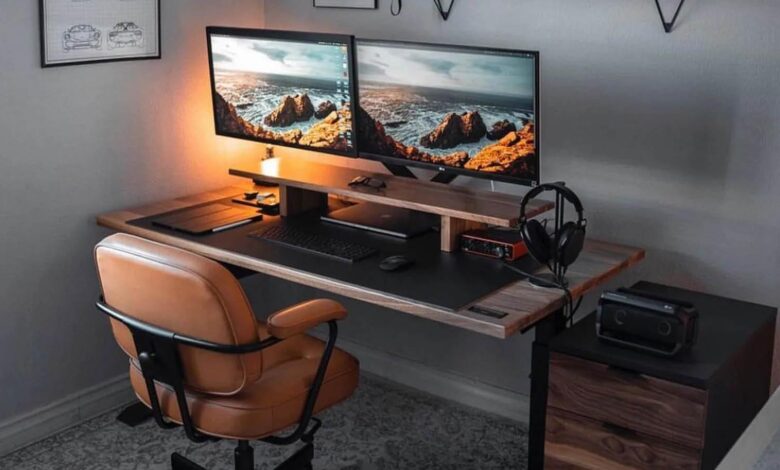Office Workstations in the Digital Age: Tech Essentials for Every Desk

In today’s fast-paced and increasingly digital world, the traditional office furniture setup has evolved significantly. Office workstations are no longer just about a desk and a chair; they are now highly dynamic environments that integrate technology to enhance productivity, comfort, and efficiency. Whether you work from home or in an office environment, the role of office furniture has expanded to support the growing need for digital tools and connected devices. This blog explores the essential tech elements every modern office workstation should have to stay competitive and efficient in the digital age.
The Importance of Ergonomics and Tech Integration
When setting up an office workstation, ergonomics is the cornerstone of creating a comfortable and healthy work environment. A well-designed office chair, a spacious desk, and accessories like keyboard trays and monitor stands can make all the difference in how you feel after a long day of work. However, with the growing reliance on technology, ergonomic office furniture needs to work seamlessly with digital devices.
For example, a desk with cable management options helps keep cords organised, preventing clutter and allowing for better airflow around devices like computers and monitors. Adjustable standing desks are also a fantastic option, offering flexibility to alternate between sitting and standing throughout the day. This adjustment not only helps with physical comfort but also plays a significant role in maintaining mental focus, particularly during extended hours spent working on a computer.
Essential Tech Tools for the Modern Office Workstation
1. High-Performance Computer and Accessories
At the core of any modern office workstation is the computer. Whether it’s a desktop or a laptop, the machine should be capable of handling the tasks you perform regularly. This means ensuring that it has sufficient processing power, memory, and storage for multitasking and running resource-heavy applications, especially if your work involves graphics design, video editing, or large data analysis.
Beyond the computer itself, other accessories can further enhance your workstation setup. A high-quality monitor is essential for reducing eye strain and improving productivity, especially for tasks that require a lot of screen space, such as data entry or design work. Look for a monitor with adjustable height, tilt, and swivel functionality to maintain a comfortable viewing angle. Additionally, an ergonomic keyboard and mouse, designed to reduce wrist strain, can significantly improve comfort over long periods of typing or navigating.
2. Smart Speakers and Virtual Assistants
Integrating voice-controlled smart speakers and virtual assistants into your office workstation is an easy way to boost efficiency. Tools like Amazon’s Alexa, Google Assistant, or Apple’s Siri can help you manage tasks hands-free, such as setting reminders, checking the weather, or even managing your calendar. They also allow you to control your office’s lighting or temperature without having to leave your desk, contributing to a seamless and efficient work environment.
3. Collaboration Tools and Video Conferencing Setup
In the digital age, remote work and collaboration tools have become indispensable. Video conferencing platforms like Zoom, Microsoft Teams, and Google Meet have transformed the way teams work together. Having the right tech tools is essential for these platforms to run smoothly.
Ensure your workstation is equipped with a high-quality webcam and microphone to ensure crystal-clear communication during virtual meetings. A noise-cancelling microphone or headset can help eliminate background noise, making it easier for colleagues or clients to hear you clearly. Depending on the nature of your meetings, a dual-monitor setup can improve your productivity, allowing you to have video calls on one screen while accessing documents or presentations on the other.
4. High-Speed Internet Connection
A reliable and fast internet connection is the backbone of any office workstation in the digital age. Whether you’re downloading large files, attending video conferences, or accessing cloud-based applications, a strong and stable internet connection is a must-have. Investing in a high-speed broadband service is crucial for smooth operations, and for those working remotely, having a backup connection, such as a mobile hotspot, can prevent potential disruptions during critical work periods.
Organising Your Workstation for Maximum Productivity
1. Cable Management Solutions
Cluttered cables are not just an aesthetic issue; they can affect your workspace’s functionality and safety. Modern office furniture is designed with cable management systems that can help you keep wires under control. These systems can include built-in trays, hooks, and channels that allow cables to be neatly routed under desks or along the sides, keeping them out of sight and preventing tripping hazards.
In addition, wireless chargers and Bluetooth-enabled devices reduce the number of cables you need, keeping your workspace cleaner and more streamlined.
2. Task Lighting and Adjustable Lighting Systems
Lighting is an often overlooked yet crucial part of a modern office workstation. Good lighting reduces eye strain and boosts focus, so consider a flexible, adjustable desk lamp with features like brightness control and colour temperature adjustments. This can help create the perfect lighting conditions for any task, whether you’re working late into the night or in a sun-drenched room.
Additionally, smart lighting systems that adjust based on time of day or your preferences can enhance your productivity and well-being. These systems can be controlled via smartphone apps or integrated with your virtual assistant for a truly smart workspace.
Future-Proofing Your Office Workstation
As technology continues to evolve, it’s essential to design your office workstation with flexibility in mind. Investing in modular office furniture that can be easily upgraded or reconfigured will ensure that your workspace remains relevant in the face of new technological advancements. Wireless charging stations, advanced monitor arms, or even furniture with built-in speakers and microphones are great examples of how office furniture can keep pace with the changing needs of a digital workspace.
Moreover, as hybrid work becomes the norm, having a workstation that supports both in-person and remote work seamlessly is crucial. This means having the ability to quickly adapt your workstation for video calls, presentations, or collaborative projects while ensuring that your tech tools remain accessible and user-friendly.
Conclusion
Creating the perfect office workstation in the digital age goes far beyond choosing the right desk and chair. By integrating ergonomic office furniture with the latest technology and organisation solutions, you can build a productive and comfortable workspace that supports both your professional and personal needs. From high-performance computers and smart assistants to clever cable management and task lighting, the right tech essentials are critical for staying efficient and competitive in the modern work environment. With the right combination of office furniture and technology, your workstation can become a powerful tool for success in the digital age.



